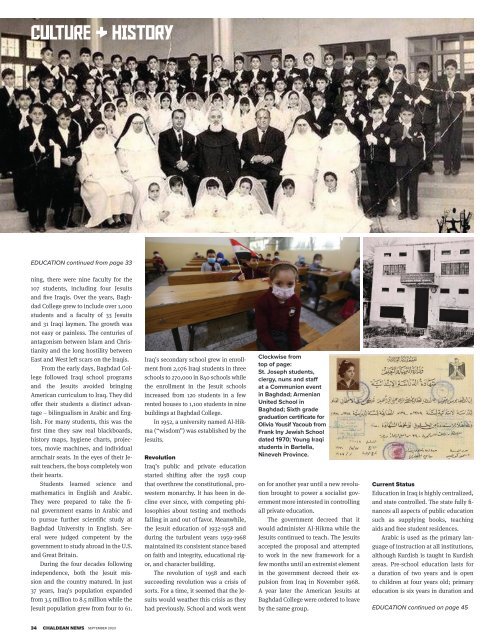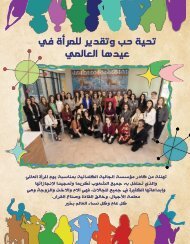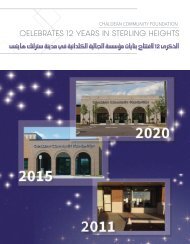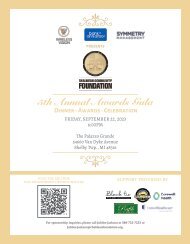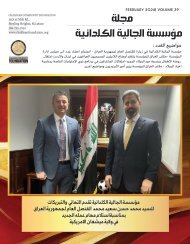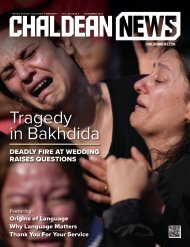You also want an ePaper? Increase the reach of your titles
YUMPU automatically turns print PDFs into web optimized ePapers that Google loves.
CULTURE & HISTORY<br />
EDUCATION continued from page 33<br />
ning, there were nine faculty for the<br />
107 students, including four Jesuits<br />
and five Iraqis. Over the years, Baghdad<br />
College grew to include over 1,000<br />
students and a faculty of 33 Jesuits<br />
and 31 Iraqi laymen. The growth was<br />
not easy or painless. The centuries of<br />
antagonism between Islam and Christianity<br />
and the long hostility between<br />
East and West left scars on the Iraqis.<br />
From the early days, Baghdad College<br />
followed Iraqi school programs<br />
and the Jesuits avoided bringing<br />
American curriculum to Iraq. They did<br />
offer their students a distinct advantage<br />
– bilingualism in Arabic and English.<br />
For many students, this was the<br />
first time they saw real blackboards,<br />
history maps, hygiene charts, projectors,<br />
movie machines, and individual<br />
armchair seats. In the eyes of their Jesuit<br />
teachers, the boys completely won<br />
their hearts.<br />
Students learned science and<br />
mathematics in English and Arabic.<br />
They were prepared to take the final<br />
government exams in Arabic and<br />
to pursue further scientific study at<br />
Baghdad University in English. Several<br />
were judged competent by the<br />
government to study abroad in the U.S.<br />
and Great Britain.<br />
During the four decades following<br />
independence, both the Jesuit mission<br />
and the country matured. In just<br />
37 years, Iraq’s population expanded<br />
from 3.5 million to 8.5 million while the<br />
Jesuit population grew from four to 61.<br />
Iraq’s secondary school grew in enrollment<br />
from 2,076 Iraqi students in three<br />
schools to 270,000 in 840 schools while<br />
the enrollment in the Jesuit schools<br />
increased from 120 students in a few<br />
rented houses to 1,100 students in nine<br />
buildings at Baghdad College.<br />
In 1952, a university named Al-Hikma<br />
(“wisdom”) was established by the<br />
Jesuits.<br />
Revolution<br />
Iraq’s public and private education<br />
started shifting after the 1958 coup<br />
that overthrew the constitutional, prowestern<br />
monarchy. It has been in decline<br />
ever since, with competing philosophies<br />
about testing and methods<br />
falling in and out of favor. Meanwhile,<br />
the Jesuit education of 1932-1958 and<br />
during the turbulent years 1959-1968<br />
maintained its consistent stance based<br />
on faith and integrity, educational rigor,<br />
and character building.<br />
The revolution of 1958 and each<br />
succeeding revolution was a crisis of<br />
sorts. For a time, it seemed that the Jesuits<br />
would weather this crisis as they<br />
had previously. School and work went<br />
Clockwise from<br />
top of page:<br />
St. Joseph students,<br />
clergy, nuns and staff<br />
at a Communion event<br />
in Baghdad; Armenian<br />
United School in<br />
Baghdad; Sixth grade<br />
graduation certificate for<br />
Olivia Yousif Yacoub from<br />
Frank Iny Jewish School<br />
dated 1970; Young Iraqi<br />
students in Bartella,<br />
Nineveh Province.<br />
on for another year until a new revolution<br />
brought to power a socialist government<br />
more interested in controlling<br />
all private education.<br />
The government decreed that it<br />
would administer AI-Hikma while the<br />
Jesuits continued to teach. The Jesuits<br />
accepted the proposal and attempted<br />
to work in the new framework for a<br />
few months until an extremist element<br />
in the government decreed their expulsion<br />
from Iraq in November 1968.<br />
A year later the American Jesuits at<br />
Baghdad College were ordered to leave<br />
by the same group.<br />
Current Status<br />
Education in Iraq is highly centralized,<br />
and state controlled. The state fully finances<br />
all aspects of public education<br />
such as supplying books, teaching<br />
aids and free student residences.<br />
Arabic is used as the primary language<br />
of instruction at all institutions,<br />
although Kurdish is taught in Kurdish<br />
areas. Pre-school education lasts for<br />
a duration of two years and is open<br />
to children at four years old; primary<br />
education is six years in duration and<br />
EDUCATION continued on page 45<br />
34 CHALDEAN NEWS <strong>SEPTEMBER</strong> <strong>2023</strong>


